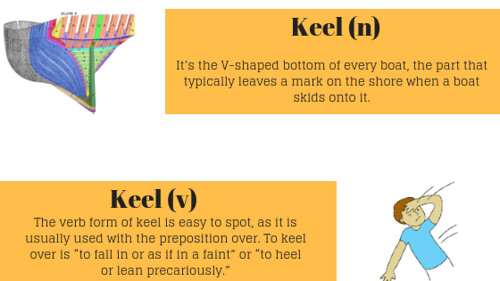Grammar Chaos: Knowing the Difference between Keel and Kneel
Posted on Jan 16, 2019
Tripping over in front of a crowd can be embarrassing, painful, and sometimes, scarring. Misusing a word can be just as mortifying, but what’s important is that we recover from the fall and learn from our mistake. The words keel and kneel tend to confuse people with their similarities—let’s get into their specifics now before we learn them the hard way.

Keel and kneel have nearly the same spelling, and this can make it hard to read. But they differ substantially in their pronunciation, as their first syllables are pronounced differently. The former starts with a /k/ sound, and the latter begins with an /n/ sound. Reading the words out loud will help determine which is which at the onset.
Knowing what the words are used for will make it even easier to distinguish them. Keel is both a noun and a verb. Its noun form is defined as “the chief structural member of a boat or ship that extends longitudinally along the center of its bottom and that often projects from the bottom.” It’s the V-shaped bottom of every boat, the part that typically leaves a mark on the shore when a boat skids onto it. The word also refers to any similar projections or structures, such as keel-shaped ridges. Another more situational usage of keel refers to a “flat-bottomed barge that is used to transport coal.”
The verb form of keel is easy to spot, as it is usually used with the preposition over. To keel over is “to fall in or as if in a faint” or “to heel or lean precariously.” An example of the former is when a tired office worker suddenly keels over the sidewalk on the way home. For the latter, one could refer to the way someone keels over the edge of a cliff just to take the perfect selfie.

Kneel should be easier to spot since it isn’t joined at the hip with over. When one kneels, they “position the body so that one or both knees rest on the floor.” For example, people go to church and kneel at the pews. Take note that kneel can only be used as a verb, unlike the dual-purpose keel.
For further demonstration of their definitions, here are some sample sentences:
The Coraline Siren’s coral-lined and shell-encrusted keel was notoriously impractical, even among luxury sailors.
Mauro is kneeling in front of the Dalenian royalty, begging for their mercy and for a chance to atone.
Under the punishing heat of Baronia’s desert sun, Queen Geneva’s heavily armored soldiers keeled over before even making it past the city’s outer perimeter.
The young girl knelt beside her little brother, offering the comfort their mother deprived him of.
The builders feared that the vessel will keel over and send some of its crew overboard—worse, capsize and drown them all.
Arturia gathered enough allies and mustered all her nation’s military power to make sure her enemies will kneel before her.
Another way to differentiate the verb forms easily is their intent. Kneeling is done on purpose while keeling over typically happens by accident, either from fatigue or uncontrollable situations. When all else fails, remember that kneel cannot be spelled without knee, the body part you use to perform this action. Once you see knee there, you know what it means.
That should be everything needed to keep one’s tongue from tripping over keel and kneel. If you’ve got other questions on grammar and writing, just let us know and we’ll respond as soon as we can. Until next time!
Sources:
- Keel Over | Definition of Keel Over by Merriam-Webster
- Keel | Definition of Keel by Merriam-Webster
- Kneel | Definition of Kneel by Merriam-Webster
Disclaimer: Images are not ours. Credit to the owner.
About 1-Hour Proofreading
1-Hour Proofreading is a growing start-up offering fast and efficient editing services at a reasonable price, with the assurance that the document is publication-ready the soonest you need it. Its team of highly competent professional editors is committed to helping those in need of quality editing services while facing tough deadlines.
Visit 1hourproofreading.com for more details.
Follow us:
Back to Grammary



